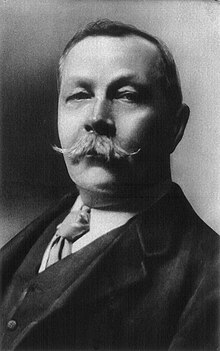About the Book: "The Adventure of the Norwood Builder", one of the 56 short Sherlock Holmes stories written by British author Sir Arthur Conan Doyle, is the second tale from The Return of Sherlock Holmes. The story was first published in Strand Magazine in 1903 with original illustrations by Sidney Paget.
About the Author: Arthur Ignatius Conan Doyle was born on 22 May 1859 at 11 Picardy Place, Edinburgh, Scotland. From 1876 to 1881, he studied medicine at the University of Edinburgh, including a period working in the town of Aston (now a district of Birmingham) and in Sheffield, as well as in Shropshire at Ruyton-XI-Towns. While studying, Doyle began writing short stories. His earliest extant fiction, "The Haunted Grange of Goresthorpe", was unsuccessfully submitted to Blackwood's Magazine. His first published piece "The Mystery of Sasassa Valley", a story set in South Africa, was printed in Chambers's Edinburgh Journal on 6 September 1879. On 20 September 1879, he published his first non-fiction article, "Gelsemium as a Poison" in the British Medical Journal. In 1882 he joined former classmate George Turnavine Budd as his partner at a medical practice in Plymouth, but their relationship proved difficult, and Doyle soon left to set up an independent practice. Arriving in Portsmouth in June of that year with less than £10 (£900 today) to his name, he set up a medical practice at 1 Bush Villas in Elm Grove, Southsea. The practice was initially not very successful. While waiting for patients, Doyle again began writing stories and composed his first novels, The Mystery of Cloomber, not published until 1888, and the unfinished Narrative of John Smith, which would go unpublished until 2011. He amassed a portfolio of short stories including "The Captain of the Pole-Star" and "J. Habakuk Jephson's Statement", both inspired by Doyle's time at sea, the latter of which popularized the mystery of the Mary Celeste and added fictional details such as the perfect condition of the ship (which had actually taken on water by the time it was discovered) and its boats remaining on board (the one boat was in fact missing) that have come to dominate popular accounts of the incident. Doyle struggled to find a publisher for his work. His first significant piece, A Study in Scarlet, was taken by Ward Lock Co. on 20 November 1886, giving Doyle £25 for all rights to the story. The piece appeared later that year in the Beeton's Christmas Annual and received good reviews in The Scotsman and the Glasgow Herald. The story featured the first appearance of Watson and Sherlock Holmes, partially modeled after his former university teacher Joseph Bell. Doyle wrote to him, "It is most certainly to you that I owe Sherlock Holmes ... Round the center of deduction and inference and observation which I have heard you inculcate I have tried to build up a man." Robert Louis Stevenson was able, even in faraway Samoa, to recognize the strong similarity between Joseph Bell and Sherlock Holmes: "My compliments on your very ingenious and very interesting adventures of Sherlock Holmes. ... Can this be my old friend Joe Bell?" Other authors sometimes suggest additional influences—for instance, the famous Edgar Allan Poe character C. Auguste Dupin. A sequel to A Study in Scarlet was commissioned and The Sign of the Four appeared in Lippincott's Magazine in February 1890, under agreement with the Ward Lock company. Doyle felt grievously exploited by Ward Lock as an author new to the publishing world and he left them. Short stories featuring Sherlock Holmes were published in the Strand Magazine. Doyle first began to write for the 'Strand' from his home at 2 Upper Wimpole Street, now marked by a memorial plaque. In this period, however, Holmes was not his sole subject and in 1893, he collaborated with J.M. Barrie on the libretto of Jane Annie. Doyle was found clutching his chest in the hall of Windlesham Manor, his house in Crowborough, East Sussex, on 7 July 1930. He died of a heart attack at the age of 71. His last words were directed toward his wife: "You are wonderful." At the time of his death, there was some controversy concerning his burial place, as he was avowedly not a Christian, considering himself a Spiritualist. He was first buried on 11 July 1930 in Windlesham rose garden. He was later reinterred together with his wife in Minstead churchyard in the New Forest, Hampshire. Carved wooden tablets to his memory and to the memory of his wife are held privately and are inaccessible to the public. That inscription reads, "Blade straight / Steel true / Arthur Conan Doyle / Born May 22nd 1859 / Passed On 7th July 1930." The epitaph on his gravestone in the churchyard reads, in part: "Steel true/Blade straight/Arthur Conan Doyle/Knight/Patriot, Physician, and man of letters". Undershaw, the home near Hindhead, Haslemere, south of London, that Doyle had built and lived in between October 1897 and September 1907, was a hotel and restaurant from 1924 until 2004. It was then bought by a developer and stood empty while conservationists and Doyle fans fought to preserve it. In 2012 the High Court ruled that the redevelopment permission be quashed because proper procedure had not been followed. A statue honours Doyle at Crowborough Cross in Crowborough, where he lived for 23 years. There is also a statue of Sherlock Holmes in Picardy Place, Edinburgh, close to the house where Doyle was born.
My Review: Another superb story: The Norwood Builder is Jonas Oldacre, 52, reclusive retired bachelor, who vanished the night before (July+ 1894) from his house, not found when the lumber in his yard caught fire in a tremendous conflagration. His bed was unused, his safe open, papers scattered, signs of struggle, a large object dragged from safe to woodpile then burned, and blood on an oak cane belonging to late-night visitor, junior lawyer John McFarlane. The suspect bursts into Baker Street distraught, showing Holmes the news article that diverted him from his homeward train, and begs Holmes to help him.
As McFarlane relates his story, Lestrade, accompanied by constables, suddenly arrests his man, but agrees to listen to his story for half an hour. Yesterday at 3 pm, ferret-faced Oldacre, his name known as an acquaintance of the youth's parents, bade McFarlane turn scribbles into a legal will, with McFarlane learning to his surprise that Oldacre has made him his sole heir as Oldacre lacks any other family and has heard good things about him due to his past connection to McFarlane's parents. After witnessing and signing, the benefactor asked him for dinner at nine, to see essential paperwork details, and not tell his parents. Around midnight they finished sorting paper into sealed envelopes, and, admonished not to disturb the housekeeper, he was ushered, without his cane, out of the French window, safe still ajar. After the constables leave with their prisoner, Holmes explains the will's rough draft varies from clear to unreadable where the writer's train stopped at stations, then rumbled roughly.
Holmes investigates. At Blackheath, fluffy little mother McFarlane reveals Oldacre to be a vicious vengeful ex-suitor, rejected after he loosed a cat in an aviary. At Norwood trouser buttons from Oldacre's tailor are found among charred organic remains, examination of the remaining documents reveals allusions to missing valuable deeds, and a low bank balance attributable to recent large cheques to Mr. Cornelius. Defiant, guilty-eyed housekeeper Mrs. Lexington smelled burnt flesh the night before, and knows more than she says, that the visitor's hat and cane were both left in the front hall.
Next morning, Lestrade telegrams Holmes to come see McFarlane's bloody right thumbprint below the hat-peg, pointed out by Lexington. Holmes knows the evidence was not there yesterday, and minutely examines the whole house. He asks Lestrade for loud-voiced constables, and all cry "fire" after large straw bundles are lit, to smoke out their missing witness, Oldacre, from behind solid-seeming walls. Holmes gives Lestrade the victory, wagers one of the thumbprints sealing the safe papers is McFarlane's, that Oldacre filled with blood and transferred. Mr. Cornelius is probably an alter identity Oldacre had intended to take on permanently, the bitter man seeking revenge on his former lover by creating the illusion that he was murdered by her only child. Holmes notes with amusement that the thumb-print was actually the give-away clue; prior to the print's discovery, even Holmes suspected that McFarlane might be guilty, but Oldacre's inability to know when to stop creating his illusion caused him to expose himself. Under guard in the parlor, the villain whines that he intended it all to be a joke, and refuses to admit what flesh burned in the fire, so Holmes suggests Watson ascribe rabbits. Oldacre will be charged with conspiracy to commit murder and "Mr Connelius" bank account will be confiscated by Oldacre's crediters.
I recomment this book to all readers that enjoy a well written mystery book.
If you read this review, feel free to leave a comment.



No comments:
Post a Comment